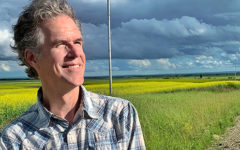
Ask Sonny Anything is a recurring feature where our readers pose questions to the great Sonny Osborne, one half of the iconic Osborne Brothers who redefined bluegrass music in the 1960s, and noted banjo maven and collector of fine prewar instruments. Everyone is encouraged to pose queries of your own each week in the comments, about his history in the music, his wealth of banjo knowledge, or regarding any life advice you might be needing.
Sonny, I really enjoyed the Dobro playing of Gene Wooten when he was part of the group. What made you decide to add Gene and the Dobro to the Osborne Brothers sound? Were their other Dobro players in the group along the way?
Thanks,
Jeff S.
Seattle, WA
Jeff, thank you for your input. WITHOUT YOU GUYS AND GALS WE GO KERPLUNK!
We had a dobro back in the late ’50s when we worked at WWVA in Wheeling. Ricky Russell. We didn’t get used to the sound because we actually couldn’t afford it. We were having enough trouble keeping afloat as it was without the extra guy. Gene-o came with us on a date in Kentucky when Blaine Sprouse could not go. Reason, he was going to law school and they had an important test that had to be done, and could not be made up, so Blaine stayed in Nashville and I think Smith or Eldredge suggested we ask Gene to go with us. Covington, Kentucky I think. He played so different than most Dobro players, who at that time were into the Josh Graves sound.
We were impressed with Gene and asked him if he would be interested in working with us on a full time basis. He accepted, and was there 11 years… until his death.
Funny things happened with Gene. He carried a Raven 25 automatic in his pocket. That pistol was notorious for having a bad safety. It would just slide off without warning. So, Terry Eldredge, at the Opry one Friday night eased up to me and said; “Chief, GeneO had an accident this week.” I asked what…El said, “he shot his toe off!” About that time Gene shows up and he has a walking cast on his left foot. I asked what happened and he said, “he reached in his pocket to get a quarter to put in a telephone, and the gun went off and the bullet hit his toe.” We laughed the rest of the night.
I introduced Gene to the Grand Ole Opry crowd as: “Rootin’ Tootin’ Shootin’ 9 toed Wooten.” His face turned purple he was so mad. That intro stayed with him the rest of his life. We loved Gene. He was the best Dobro player I was ever associated with. He got the best tone, and played with more feeling. We have a video floating around on YouTube of a medley we did in Renfro Valley, Kentucky. The last song of the medley is, Today I Started Loving You Again. Gene’s break is the best.
s
—–
Hi Sonny,
I first became a fan because of my Dad, he was a HUGE fan. He went to your shows, even met you guys. Listening to you music brings back my Dad for a little while. I’ve recently started to learn banjo and there is an abundance of material. Do you have something you could recommend? Thanks and God bless.
Jerry H.
Thank you Jerry. People like your Dad made our job a bit easier. Bill Evans has a couple books he authored. Banjo for Dummies. Also Kristin Benson teaches by way of SKYPE. She is very good. I have an instruction video that I think is quite good… of course, I would say that, now wouldn’t I? I personally have not had need for any of this material, it appeared after I retired, with the exception of my instruction book which came on the market in 1964. Published by Mel Bay… and I believe it can still be bought. I think it might have been the first instruction book written for the three finger style playing. It took 6 years from beginning to end. Started it in 1958… finished in 1964.. Funny thing about that book. I have never been able to draw a straight line, but if you ever have occasion to come in contact with that book, notice on the front cover is a picture of a right hand….well, I DREW THAT PICTURE. FIRST TIME. And I tried several times and could never duplicate. GO FIGGER!
Hey Jerry, I wish I could see a picture of your Dad…there’s a pretty good chance I would remember him.
s
—–
Sonny,
Which of your albums would you say was your best? Not necessarily the most popular or biggest seller, but the album you thought was your finest work, when everything was just on the nose – vocals, tone, etc – the one that just made you say, “WOW!! We did that??!!”
Rob M.
Rob. Thank you. Man, that is a good question.
I’m not exactly sure just how to answer. I guess it would have to be the Bluegrass Collection album which had Blaine Sprouse and Kenny Baker playing twin fiddles, and Benny Birchfield sang trio with Bobby and I. And the one we did with Mac Wiseman, The Essential Bluegrass Album. Both on CMH and both double albums. We have Martin Haerle to thank for allowing us to do those two plus several more….Bobby’s mandolin album, Bluegrass Concerto, Wynn’s Banjo album… .and more. I really liked Martin… he was German and when we went to Germany he went with us. He could show us things that we wouldn’t have seen… and he described things as they were and after the war. I thoroughly enjoyed Germany. Reminded me of Kansas.
s
—–
Sonny,
There are two camps who argue whether Bill Monroe should be called the “Father of Bluegrass” or not. Certainly Earl and Louise felt it was a group effort and therefore should be credited to the original band, not simply Bill alone. What are your thoughts on this controversial issue?
Stan F.
Stan. Thank you for your contribution. Really appreciated.
My thoughts are quite clear. Bill Monroe should get the credit because it was his band, he furnished the dates they played, the vehicle they rode in, and he was paying the bills. Plus, he was the one who WSM hired in 1939 to be part of the Grand Ole Opry. If a problem came up who did they all go running to…. Bill. If they needed money who did they go to… well, I shouldn’t answer that one, see… I worked there on two occasions and nothing changed from one time to the next… financially, that is.
Whether he knew what he was doing when he hired Lester, Earl, Chubby, and Howard we’ll never know, there is no one to ask… but with the addition of Earl, the music itself became more exciting, and the Opry crowds responded to the sound of Earl’s banjo style. Bill gave me the impression that he only needed his mandolin and it didn’t really matter who or what was going on around him. In fact, I actually heard him say those words. “All I need is my mandolin!” Some of you might have heard George D Hays introduce Bill as; “Bill Monroe and his Bluegrass Boys with Earl Scruggs and that fancy banjo.”
Truth is, Earl was a hot item, but Bill Monroe was the man.
s
—–
Hi Sonny, I’m president of the INLAND NORTHWEST BLUEGRASS ASSOCIATION, Spokane, Wa., and Idaho panhandle. I want to start a kid’s circle jam, ages 5 to 15. We have jams before and after out Showcase, 1st Saturday of each month. My thoughts are the youth is Bluegrass Musics’ future. Any pointers or ideas as to make the kids jam successful, and how I should set it up. I felt while the more advanced kids played, the younger kids would learn and have models to look up to. Etc. Thanks.
Wyonia Farner
President
INBMA
—–
THIS FROM BILL EVANS.
To Wyonia Farner
You can’t force music upon kids of any age, as this could backfire when kids get old enough to make their own decisions about how they spend their time. The first step is to provide an environment where the music is around them and make that a positive thing. Taking them to jams, festivals and concerts and then connecting with other families who have children of a similar age is a great first step. Be ready for that moment when a child says “I’d like to play ____!,” by having an instrument ready and someone to help provide some first lessons.
For younger children, a full-size guitar, banjo, or bass could be too big for them (especially the bass!) and mandolins and fiddles are often difficult to fret and play. For really younger kids, a ukulele with nylon strings is a great way to get started, or a smaller guitar with light gauge strings.
And while more advanced kids can be an inspiration to younger kids, they might not be good teachers (or want to even help). This is where an adult who has an idea of how to teach a young person can be a wonderful resource.
Bill Evans
The New Mexico Flash
If you have something you would like to ask Sonny, be sure to post it in the comments below, or send it to us directly.







